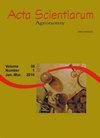Gene expression analysis associated with tissue-specific promoters in Musa spp.
IF 1.2
4区 农林科学
Q3 AGRONOMY
引用次数: 0
Abstract
The study of promoters has become essential to elucidate genetic regulation and allow new genetic transformation strategies through plant biotechnology. The challenge is to discover and validate promoters that can regulate gene transcription spatially and/or temporally. The goal of this work was to validate genes associated with tissue-specific promoters of bananas obtained from in silico sequences and selected from the DATAMusa databank. Gene expression was quantified using RT-qPCR from different tissues: leaves, flowers, roots, unripe pulp, ripe pulp, unripe peels, and ripe peels of two different genetic groups: Prata-Anã (PA; group AAB) and Grand Naine (GN; group AAA). After the analysis of the expression of genes associated with the promoters, normalization was performed with the most stable reference genes (TUB and L2) selected using the RefFinder tool. It was determined that five genes were specific or expressed to a greater extent in some tissues than others. The EMB-23 gene was highly expressed in ripe pulp and flowers of GN, EMB-26 in the ripe pulp of GN, EMB-27 in flowers of GN, EMB-28 in roots of PA and ripe pulp and roots of GN, and EMB-31 in roots and flowers of GN and PA, and unripe pulp of GN. The in silico analysis was efficient in the identification of spatial/time-specific genes, thereby decreasing analysis time and cost, making future genetic transformation studies focusing on the application of these tissue-specific promoters possible.番薯组织特异性启动子相关基因表达分析。
启动子的研究已成为阐明遗传调控和通过植物生物技术实现新的遗传转化策略的必要条件。我们面临的挑战是发现和验证能够在空间和/或时间上调控基因转录的启动子。这项工作的目的是验证与香蕉组织特异性启动子相关的基因,这些启动子是从DATAMusa数据库中选择的硅序列中获得的。采用RT-qPCR方法对两个不同遗传群的不同组织(叶、花、根、未成熟果肉、成熟果肉、未成熟果皮和成熟果皮)的基因表达进行定量分析:Prata-Anã (PA;AAB组)和Grand Naine组(GN组);组AAA)。在分析启动子相关基因的表达后,使用RefFinder工具选择最稳定的内参基因(TUB和L2)进行归一化。确定了五个基因在某些组织中特异性或表达程度高于其他组织。EMB-23基因在GN成熟果肉和花中高表达,EMB-26基因在GN成熟果肉中高表达,EMB-27基因在GN花中高表达,EMB-28基因在PA根和成熟果肉和根中高表达,EMB-31基因在GN根和花中高表达,EMB-31基因在GN未成熟果肉中高表达。计算机分析在识别空间/时间特异性基因方面效率高,从而减少了分析时间和成本,使未来的遗传转化研究重点放在这些组织特异性启动子的应用上成为可能。
本文章由计算机程序翻译,如有差异,请以英文原文为准。
求助全文
约1分钟内获得全文
求助全文
来源期刊

Acta Scientiarum. Agronomy.
Agricultural and Biological Sciences-Agronomy and Crop Science
CiteScore
2.40
自引率
0.00%
发文量
45
审稿时长
>12 weeks
期刊介绍:
The journal publishes original articles in all areas of Agronomy, including soil sciences, agricultural entomology, soil fertility and manuring, soil physics, physiology of cultivated plants, phytopathology, phyto-health, phytotechny, genesis, morphology and soil classification, management and conservation of soil, integrated management of plant pests, vegetal improvement, agricultural microbiology, agricultural parasitology, production and processing of seeds.
 求助内容:
求助内容: 应助结果提醒方式:
应助结果提醒方式:


